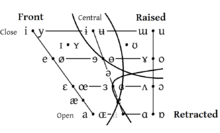Front vowel
A front vowel is any in a class of vowel sound used in some spoken languages, its defining characteristic being that the tongue is positioned as far in front as possible in the mouth without creating a constriction that would make it a consonant. Front vowels are sometimes also called bright vowels because they are perceived as sounding brighter than the back vowels.[1]
Near-front vowels are essentially a type of front vowels; no language is known to contrast front and near-front vowels based on backness alone.
Rounded front vowels are typically centralized, that is, near-front in their articulation. This is one reason they are written to the right of unrounded front vowels in the IPA vowel chart.
Partial list
The front vowels that have dedicated symbols in the International Phonetic Alphabet are:
- close front unrounded vowel [i]
- close front compressed vowel [y]
- close-mid front unrounded vowel [e]
- close-mid front rounded vowel [ø]
- open-mid front unrounded vowel [ɛ]
- open-mid front rounded vowel [œ]
- near-open front unrounded vowel [æ]
- open front unrounded vowel [a]
- open front rounded vowel [ɶ]
There also are front vowels without dedicated symbols in the IPA:
- close front protruded vowel [yʷ] (y̫)
- close-mid front protruded vowel [øʷ] (ø̫)
- mid front unrounded vowel [e̞] or [ɛ̝] (commonly written ⟨e⟩ as if it were close-mid)
- mid front compressed vowel [ø̞] or [œ̝] (commonly written ⟨ø⟩ as if it were close-mid)
- mid front protruded vowel [ø̞ʷ] or [œ̝ʷ]
- open-mid front protruded vowel [œʷ] (œ̫)
As above, other front vowels can be indicated with diacritics of relative articulation applied to letters for neighboring vowels, such as ⟨i̞⟩, ⟨e̝⟩ or ⟨ɪ̟⟩ for a near-close front unrounded vowel.
Articulatory front vowels

In articulation, front vowels contrast with raised vowels and retracted vowels. In this conception, front vowels are a broader category than those listed in the IPA chart, including [ɪ ʏ], [ɨ ʉ], and, marginally, mid-central vowels. Raised or retracted vowels may be fronted by certain consonants, such as palatals and in some languages pharyngeals. For example, /a/ may be fronted to [æ] next to /j/ or /ħ/.[2]
Effect on preceding consonant
In the history of many languages, for example French and Japanese, front vowels have altered preceding velar or alveolar consonants, bringing their place of articulation towards palatal or postalveolar. This change can be allophonic variation, or it can have become phonemic.
This historical palatalization is reflected in the orthographies of several European languages, including the "c" and "g" of almost all Romance languages, the "k" and "g" in Norwegian, Swedish, Faroese and Icelandic, and the "κ", "γ" and "χ" in Greek. English follows the French pattern, but without as much regularity. However, for native or early borrowed words affected by palatalization, English has generally altered the spelling after the pronunciation (Examples include cheap, church, cheese, churn from *k, and yell, yarn, yearn, yeast from *ɡ.)
| Before back vowel: hard | Before front vowel: soft | |
|---|---|---|
| English "C" | call [kɔːl] | cell [sɛl] |
| English "G" | gall [ɡɔːl] | gel [dʒɛl] |
| French "C" | calque [kalk] | cela [səla] |
| French "G" | gare [ɡɑʁ] | gel [ʒɛl] |
| Italian "C" | cara [kara] | ciao [tʃao̯] |
| Italian "G" | gallo [ɡalːo] | genere [ˈdʒɛnere] |
| Italian "SC" | scala [skala] | scena [ˈʃɛna] |
| Swedish "K" | karta [kɑːʈa] | kär [ɕæːr] |
| Swedish "G" | god [ɡuːd] | göra [jœːra] |
| Swedish "SK" | skal [skɑːl] | skäl [ɧɛːl] |
See also
References
- ↑ Tsur, Reuven (February 1992). The Poetic Mode of Speech Perception. Duke University Press. p. 20. ISBN 0-8223-1170-4.
- ↑ Scott Moisik, Ewa Czaykowska-Higgins, & John H. Esling (2012) "The Epilaryngeal Articulator: A New Conceptual Tool for Understanding Lingual-Laryngeal Contrasts"

